Breeding Better Beef: LSU’s Research Works to Transform Louisiana’s Cattle Industry
September 26, 2025
In Louisiana, where heat and humidity dominate much of the year, raising high-quality beef that tolerates the weather is challenging. Traditional cattle breeds that thrive in cooler climates often don’t adapt well to the Gulf South. Brahman cattle, a breed known for its resilience but not necessarily for premium beef, are typically found throughout the state.
LSU scientists and the LSU AgCenter are working together to transform the state’s beef industry and the larger region. Xing Fu, associate professor in the LSU School of Animal Science, is collaborating with a team to combine genetics, breeding strategies, and practical producer training to improve both beef quality and producer profits across the region.
— Video by Grant French
The Science of Better Beef
“If we want to promote our local beef industry, I think the one good thing to do is to promote the quality of the beef we produce, and this will help the beef producer here as well,” Fu said.
Fu’s research focuses on unlocking the genetic secrets of beef quality, particularly marbling, the intramuscular fat that gives beef its tenderness, flavor, and juiciness. Fu and his team are exploring crossbreeding techniques, pairing Brahman cattle with Wagyu—a Japanese breed known for its exquisite marbling and adaptability to subtropical environments.
“When I first tasted Wagyu beef, I was amazed,” Fu said. “Now we’re studying why it tastes so good and how we can bring that quality to Louisiana cattle.”
The goal is to improve local herds by identifying genetic markers that predict better beef quality, and then using those markers in breeding.
“The Japanese Wagyu cattle, even though they're black, are from a subtropical area in Japan. So, compared to other black cattle like Angus, Wagyu cattle actually do better here,” Fu said. “Crossing Wagyu and Brahman is a simple and effective way to improve beef quality.”
From Pasture to Plate—and Lab to Field
Cobey Hendry, LSU AgCenter’s beef unit manager at the Doyle Chambers Central Research Station in Baton Rouge, believes it’s about showing producers what’s possible—and helping them get there.

Cobey Hendry feeds cattle at the Central Research Station.
– Photos by Eddy Perez
“Everything we do here supports teaching and research,” said Hendry, who also oversees the cow-calf operation at the LSU AgCenter’s Reproductive Biology Center in St. Gabriel. “We run a herd, raise calves, manage breeding programs based on research goals, and provide animals for hands-on labs for college students and local cattlemen. We also work with the LSU School of Veterinary Medicine, who bring vet students out here when we have problems.”
Through programs like the Master Cattlemen’s class, LSU AgCenter extension agents use the herd and facilities to teach best practices in breeding, feeding, and herd health. It’s a full-circle model: faculty study new techniques, staff implement them, students learn them, and producers adopt them.
“People like to eat, and beef is one of our biggest protein sources,” Hendry said. “We’re here to help producers raise calmer, healthier animals that grow better and yield higher quality cuts. That benefits everyone. We offer these resources to people so they can do better, and so overall, the industry thrives from that.”
Economic Impact and Statewide Value
Despite the demand for high-quality beef, most premium cuts sold in Louisiana grocery stores are imported from out of state. Fu believes that can—and should—change.
“If we can improve the quality of Louisiana beef, producers here can command higher prices, make more money, and the industry will be more sustainable,” Fu said.

Xing Fu and Cobey Hendry at the LSU AgCenter's Central Research Station
It’s a vision with broad implications—not just for Louisiana but neighboring Gulf Coast states that share similar environmental conditions and rely on Brahman-based herds.
“Brahman is really a dominant breed in those areas. I think the research can have a big impact on the beef production in those states,” Fu said.
A Land-Grant Mission in Action
For Hendry, who grew up around cattle in Kentwood, La., managing LSU’s herd is more than a job—it’s a dream come true.
“I graduated from LSU in 2016 then went out of state to work for another university. Then the opportunity became available to come here and manage this place,” Hendry said. “It was always a dream of mine, and now I’m living it every day.”
Working together to improve beef and the industry exemplifies LSU’s land-grant mission: turning research into real-world solutions, building stronger industries, and serving the people of Louisiana and the nation.
“Our cattle do go to feed yards. They're grown out, and they do enter the market chain as cuts of beef, and feeding America. I think it's something very important, and why people should care,” Hendry said.
Next Step
LSU's Scholarship First Agenda is helping achieve health, prosperity, and security for Louisiana and the world.


